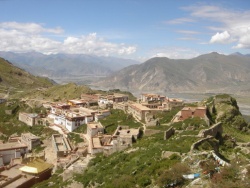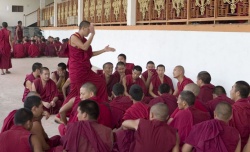Difference between revisions of "Ganden Monastery"
| Line 12: | Line 12: | ||
Being the farthest from {{Wiki|Lhasa}} of the three {{Wiki|university}} [[Monasteries]], [[Ganden]] [[traditionally]] had a smaller population with some 6,000 [[Monks]] in the early 20th century (although [[Wikipedia:Laurence Waddell|Waddell]] reports an estimate of about 3,300 in the 1890s and there were, apparently only 2,000 in 1959. At this [[Time]] there are about 170 [[Monks]]. | Being the farthest from {{Wiki|Lhasa}} of the three {{Wiki|university}} [[Monasteries]], [[Ganden]] [[traditionally]] had a smaller population with some 6,000 [[Monks]] in the early 20th century (although [[Wikipedia:Laurence Waddell|Waddell]] reports an estimate of about 3,300 in the 1890s and there were, apparently only 2,000 in 1959. At this [[Time]] there are about 170 [[Monks]]. | ||
| − | [[Ganden]] [[Monastery]] consisted of two [[principal]] original {{Wiki|colleges}}, [[Jangtse]] and [[Shartse]], meaning [[North Peak]] and [[East Peak]] respectively. The three main sights in the [[Ganden Monastery]] are the [[Serdung]], which contains the tomb of [[Tsongkhapa]], the [[Tsokchen]] Assembly Hall and the [[Ngam Cho Khang]] the chapel where [[Tsongkhapa]] [[traditionally]] taught. The [[Monastery]] houses {{Wiki|artifacts}} which belonged to [[Tsongkhapa]]. | + | [[Ganden]] [[Monastery]] consisted of two [[principal]] original {{Wiki|colleges}}, [[Jangtse]] and [[Shartse]], meaning [[North Peak]] and [[East Peak]] respectively. The three main sights in the [[Ganden Monastery]] are the [[Serdung]], which contains the tomb of [[Tsongkhapa]], the [[Tsokchen]] Assembly Hall and the [[Ngam Cho Khang]] the chapel where [[Tsongkhapa]] [[traditionally]] [[taught]]. The [[Monastery]] houses {{Wiki|artifacts}} which belonged to [[Tsongkhapa]]. |
| − | It contained more than two dozen major chapels with large [[Buddha statues]]. The largest chapel was capable of seating 3,500 [[Monks]]. [[Tenzin Gyatso]], the {{Wiki|present}} [[Dalai Lama]] (born 1935), took his final [[degree]] examination in [[Ganden]] in 1958 and he claims to [[feel]] a particularly close connection with [[Tsongkhapa]]. | + | It contained more than two dozen major chapels with large [[Buddha statues]]. The largest chapel was capable of seating 3,500 [[Monks]]. [[Tenzin Gyatso]], the {{Wiki|present}} [[Dalai Lama]] (born 1935), took his final [[degree]] {{Wiki|examination}} in [[Ganden]] in 1958 and he claims to [[feel]] a particularly close connection with [[Tsongkhapa]]. |
==Destruction in 1959 and 1966 and reconstruction efforts== | ==Destruction in 1959 and 1966 and reconstruction efforts== | ||
| Line 26: | Line 26: | ||
In the [[Tibetan]] settlement near {{Wiki|Mundgod}} are the [[Ganden]] and the [[Drepung Monastery]]. In 1999 there were in total about 13,000 residents. The [[Tibetan]] settlement consists of nine camps with two [[Monasteries]] and one [[nunnery]]. They have established a credit bank for farms, an agricultural institute and a craft center. {{Wiki|Modern}} technology and {{Wiki|communication}} technology are [[being]] introduced. The {{Wiki|curriculum}} of the [[Ganden Monastery]] {{Wiki|remains}} similar to the teachings of the pre-1959 [[Ganden Monastery]]. | In the [[Tibetan]] settlement near {{Wiki|Mundgod}} are the [[Ganden]] and the [[Drepung Monastery]]. In 1999 there were in total about 13,000 residents. The [[Tibetan]] settlement consists of nine camps with two [[Monasteries]] and one [[nunnery]]. They have established a credit bank for farms, an agricultural institute and a craft center. {{Wiki|Modern}} technology and {{Wiki|communication}} technology are [[being]] introduced. The {{Wiki|curriculum}} of the [[Ganden Monastery]] {{Wiki|remains}} similar to the teachings of the pre-1959 [[Ganden Monastery]]. | ||
| − | The [[Ganden Monastery]] {{Wiki|Colleges}} [[Jangtse]] and Shartse have also been reestablished in [[India]]. They are named The [[Ganden Jangtse College]] and The [[Gaden Shartse]] [[Monastery]]. They are located in {{Wiki|Karnataka}}. | + | The [[Ganden Monastery]] {{Wiki|Colleges}} [[Jangtse]] and [[Shartse]] have also been reestablished in [[India]]. They are named The [[Ganden Jangtse College]] and The [[Gaden Shartse]] [[Monastery]]. They are located in {{Wiki|Karnataka}}. |
| − | In 2008, over 500 [[Monks]], who refused to adhere to the ban against the protective [[Deity]] [[Dorje Shugden]], enforced by the [[Dalai Lama]]'s government in exile, were expelled from the [[Ganden Monastery]] in {{Wiki|Mundgod}}, {{Wiki|Karnataka}}, and founded in its immediate neighborhood the [[Shar Gaden Monastery]], scheduled to be officially opened in 23–26 October 2009. As a result, the [[Dokhang Khangtsen]], the biggest division of [[Gaden Shartse Monastery]], where most of the departing [[Monks]] came from, ceased to [[exist]]. | + | In 2008, over 500 [[Monks]], who refused to adhere to the ban against the protective [[Deity]] [[Dorje Shugden]], enforced by the [[Dalai Lama]]'s government in exile, were expelled from the [[Ganden Monastery]] in {{Wiki|Mundgod}}, {{Wiki|Karnataka}}, and founded in its immediate neighborhood the [[Shar Gaden Monastery]], scheduled to be officially opened in 23–26 October 2009. As a result, the [[Dokhang Khangtsen]], the biggest [[division]] of [[Gaden Shartse Monastery]], where most of the departing [[Monks]] came from, ceased to [[exist]]. |
{{W}} | {{W}} | ||
Revision as of 18:23, 7 January 2016
Ganden Monastery (also Gaden or Gandain) or Ganden Namgyeling is one of the 'great three' Gelukpa university Monasteries of Tibet, located at the top of Wangbur Mountain, Tagtse County, 36 kilometers ENE from the Potala Palace in Lhasa, at an altitude of 4,300m. (The other two 'great Monasteries' are Sera Monastery and Drepung Monastery.) Ganden `Tushita’ in Sanskrit, `Joyful Land’ in English. The Pure Land of Buddha Maitreya. Both Je Tsongkhapa and Atisha went to this Pure Land after they passed away. Also the name of the monastery in Tibet founded by Je Tsongkhapa, and of the special doctrine revealed by Je Tsongkhapa.
Its full Name is Ganden Namgyal Ling (dga' ldan rmam rgyal gling). Ganden means "joyful" and is the Tibetan Name for Tuṣita, the Heaven where the Bodhisattva Maitreya is said to reside. Namgyal Ling means "victorious temple".
History
It was the original Monastery of the Geluk Order, founded by Je Tsongkhapa himself in 1409, and traditionally considered to be the seat of Geluk administrative and political Power. The Ganden Tripa or 'throne-holder of Ganden' is the head of the Gelukpa school.
Tsongkhapa's preserved Body was entombed there in a silver and gold encrusted tomb by his disciples in 1419.
Being the farthest from Lhasa of the three university Monasteries, Ganden traditionally had a smaller population with some 6,000 Monks in the early 20th century (although Waddell reports an estimate of about 3,300 in the 1890s and there were, apparently only 2,000 in 1959. At this Time there are about 170 Monks.
Ganden Monastery consisted of two principal original colleges, Jangtse and Shartse, meaning North Peak and East Peak respectively. The three main sights in the Ganden Monastery are the Serdung, which contains the tomb of Tsongkhapa, the Tsokchen Assembly Hall and the Ngam Cho Khang the chapel where Tsongkhapa traditionally taught. The Monastery houses artifacts which belonged to Tsongkhapa.
It contained more than two dozen major chapels with large Buddha statues. The largest chapel was capable of seating 3,500 Monks. Tenzin Gyatso, the present Dalai Lama (born 1935), took his final degree examination in Ganden in 1958 and he claims to feel a particularly close connection with Tsongkhapa.
Destruction in 1959 and 1966 and reconstruction efforts
Ganden Monastery was completely destroyed during the rebellion of 1959. In 1966 it was severely shelled by Red Guard artillery and Monks then had to dismantle the remains. Most of Tsongkhapa's mummified Body was burned but his skull and some ashes were saved from the Fire by Bomi Rinpoche, the Monk who had been forced to carry the Body to the Fire. Re-building has been continuing since the 1980s and the "red-painted lhakang in the centre is the reconstruction of Ganden's sanctum sanctorum containing Tsongkapa's reliquary Chorten called the Tongwa Donden, 'Meaningful to Behold.'
Reestablishment in India
The Ganden Monastery has been re-established in Karnataka, India by the Tibetan population in exile. The Ganden Monastery is located in the Tibetan settlement at Mundgod. This settlement of Tibetan refugees is the largest of its kind in India and was first established in 1966, from land donated by the Indian government.
In the Tibetan settlement near Mundgod are the Ganden and the Drepung Monastery. In 1999 there were in total about 13,000 residents. The Tibetan settlement consists of nine camps with two Monasteries and one nunnery. They have established a credit bank for farms, an agricultural institute and a craft center. Modern technology and communication technology are being introduced. The curriculum of the Ganden Monastery remains similar to the teachings of the pre-1959 Ganden Monastery.
The Ganden Monastery Colleges Jangtse and Shartse have also been reestablished in India. They are named The Ganden Jangtse College and The Gaden Shartse Monastery. They are located in Karnataka.
In 2008, over 500 Monks, who refused to adhere to the ban against the protective Deity Dorje Shugden, enforced by the Dalai Lama's government in exile, were expelled from the Ganden Monastery in Mundgod, Karnataka, and founded in its immediate neighborhood the Shar Gaden Monastery, scheduled to be officially opened in 23–26 October 2009. As a result, the Dokhang Khangtsen, the biggest division of Gaden Shartse Monastery, where most of the departing Monks came from, ceased to exist.

